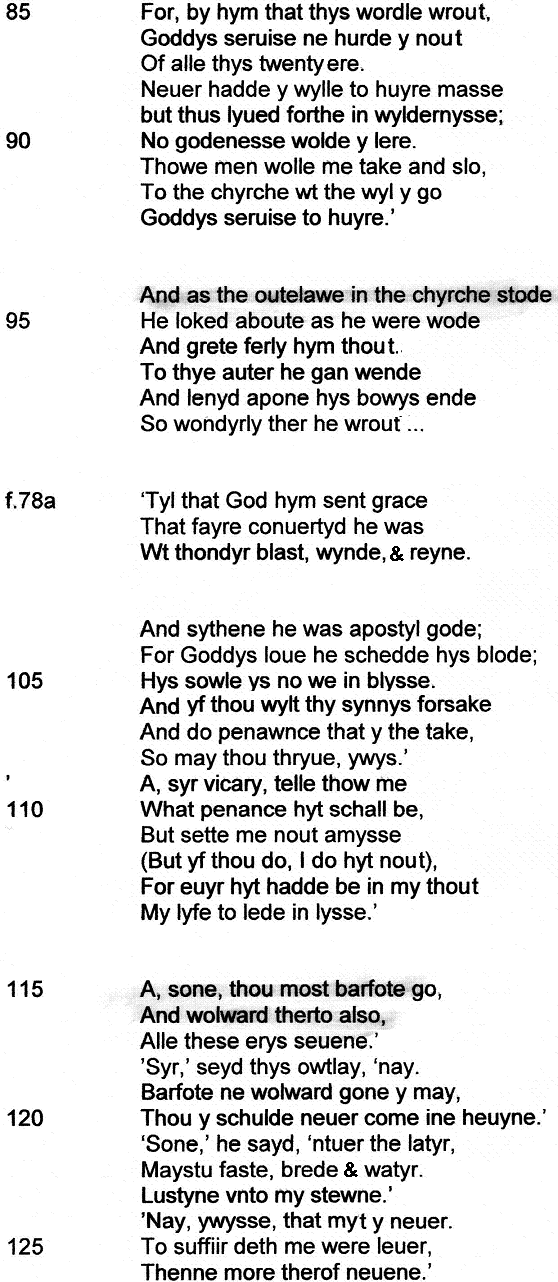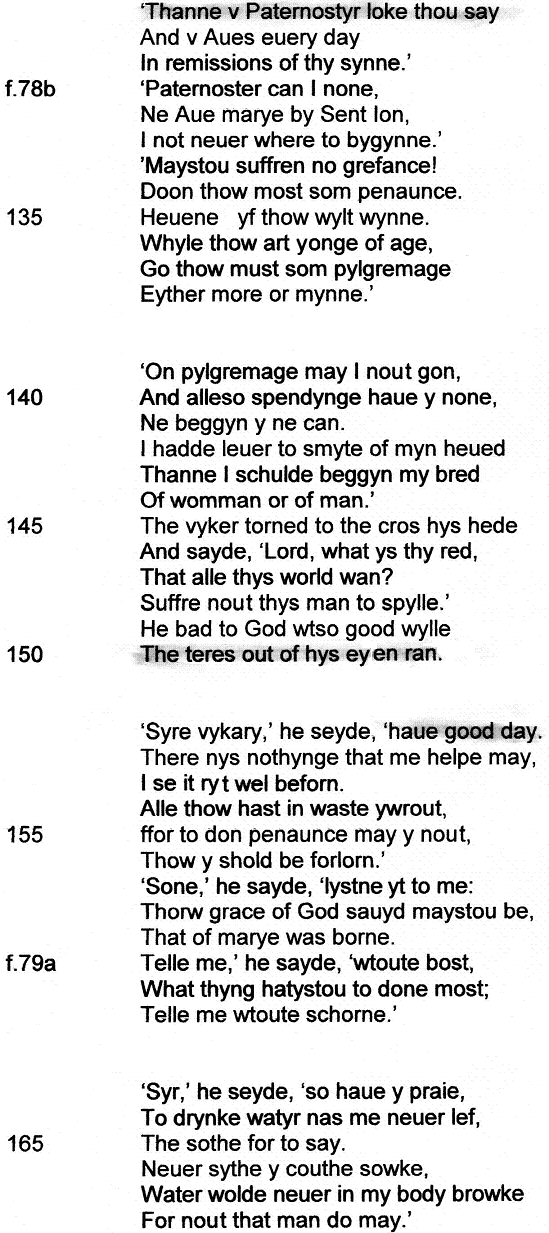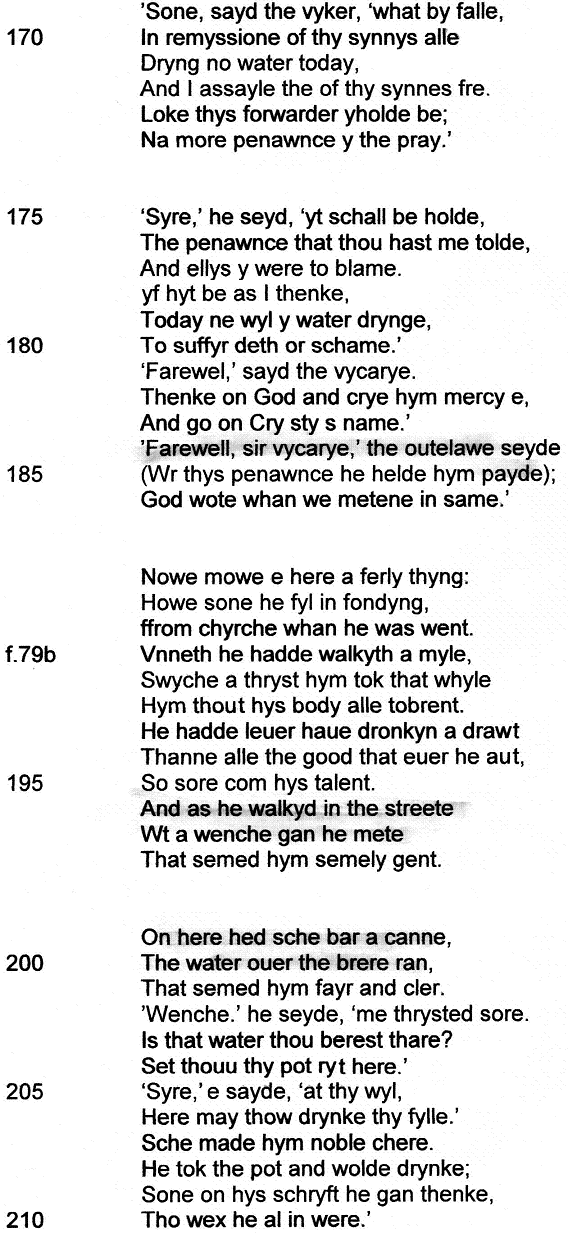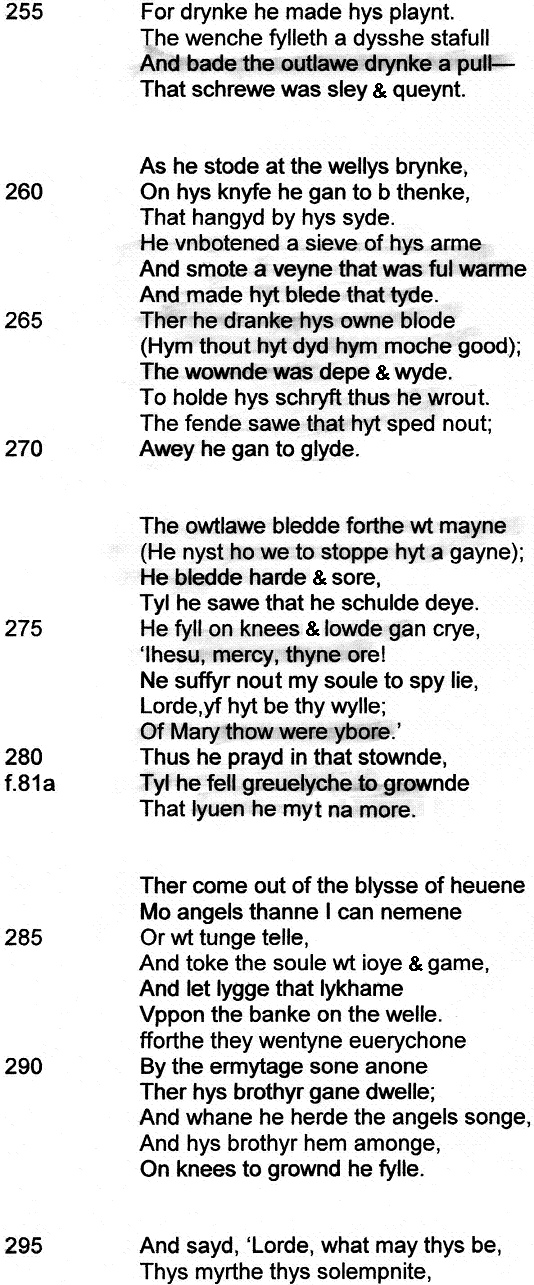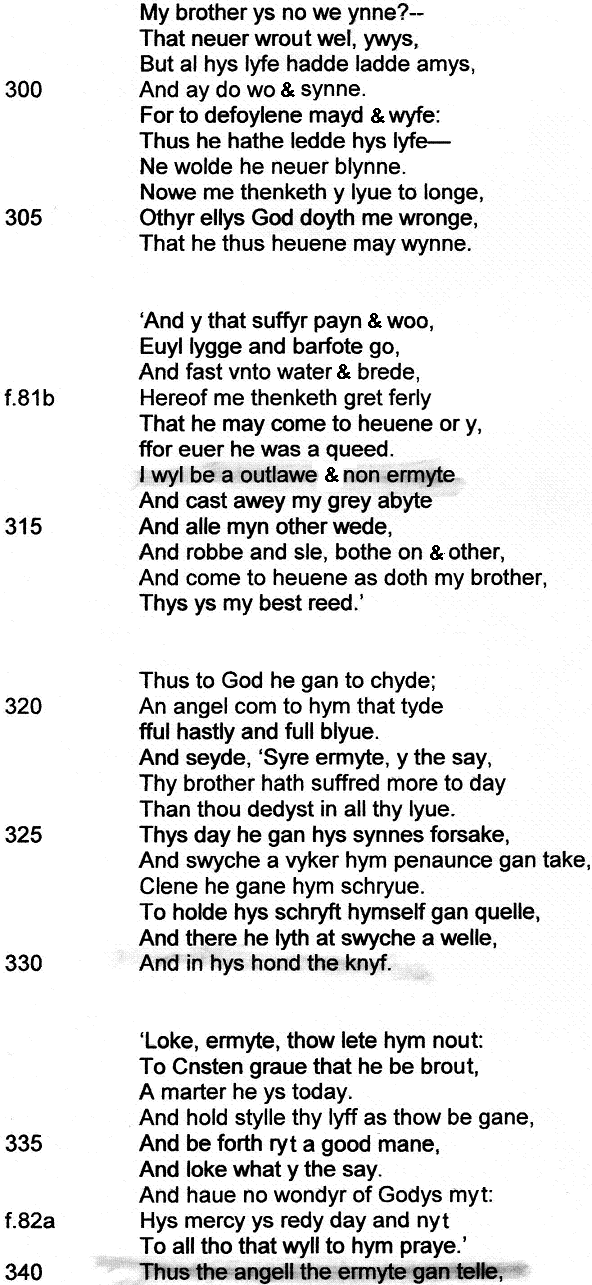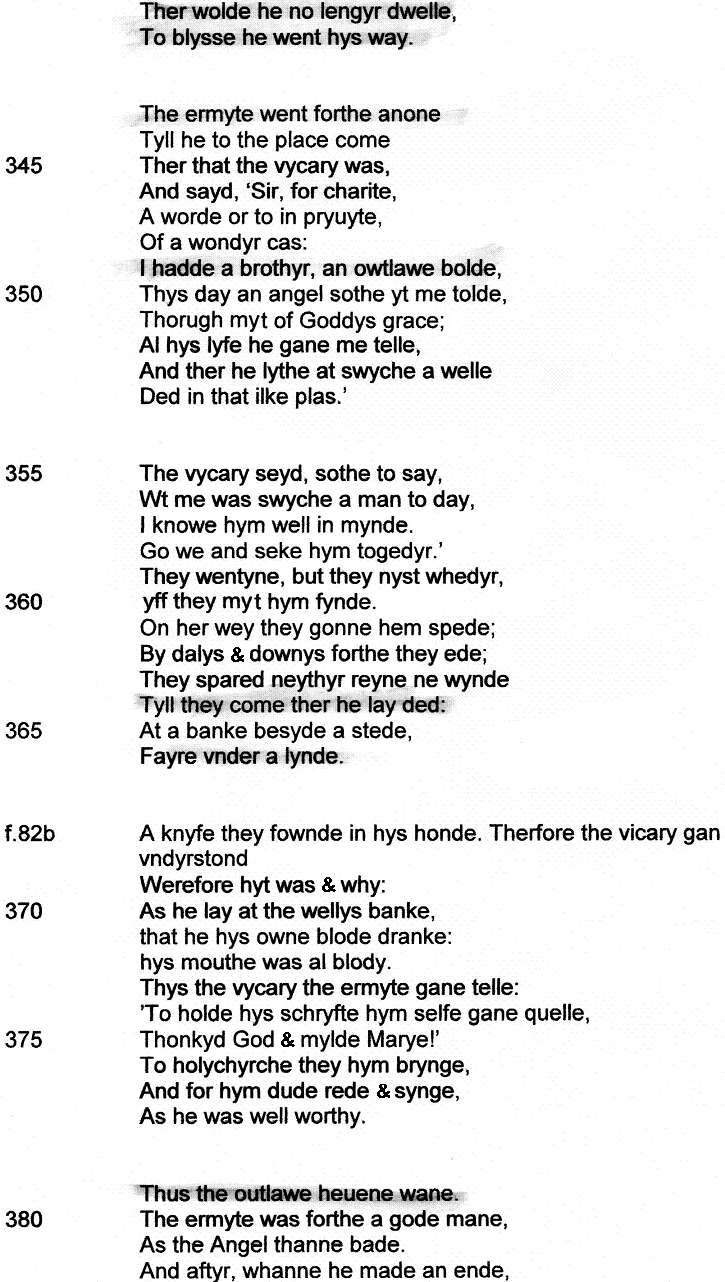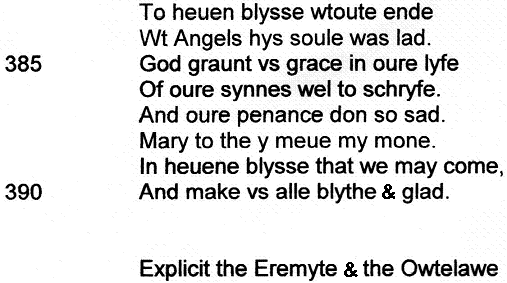The Hermit and the Outlaw
This obscure poem deserves to be presented as it contains elements that are common to the outlaw genre. Of particular interest is the death of the anonymous outlaw by bleeding; a haunting theme that reminds us of the death of Robin Hood. The Hermit and the Outlaw also contains similar wording to that which appears in certain parts of Robin Hood and the Monk, Robin Hood and the Potter, Robin Hoode his Death, and A Gest of Robyn Hode:
| The Hermit and the Outlaw | Robin Hood and the Monk | Robin Hood and the Potter | Robin Hoode his Death | A Gest of Robyn Hode | ||||
| Line 47 mentions that the outlaw: ‘hawntyd the wylde wode schawe.’ | Line 54 in Fytte One mentions: ‘That walketh by grene wode shawe’, and line 1136: ‘Under the grene wode shawe.’ | |||||||
| Line 60 has the outlaw stringing his bow: ‘Hys bowe bare ybent in honde.’ | Line 7 describes Robin Hood as: ‘On of the best that yever bare bou.’ | Line 1159 in Fytte Five has a similar theme: ‘And stande with good bowes bent’, and line 1365 in Fytte Six: ‘Sone there were gode bowes bent’, and also line 1582 in Fytte Seven: ‘Theyr bowes were smartly bent.’ | ||||||
| Lines 115-116 have the vicar saying to the outlaw: ‘A sone, thou most barfote go, And wolward therto also.’ | Lines 1767-1768 in Fytte Eight have Robin saying: ‘Barefote and wolwarde I have hyght, Thyder for to go.’ | |||||||
| Line 366 tells of the outlaw being found: ‘under a lynde.’ | Line 42 mentions: ‘Under the grene wode lynde’, line 92: ‘Under the grene wode lynde’, and line 309: ‘I have brought the under the grene wode lyne.’ | |||||||
| Lines 262-264 tell us that the outlaw: ‘unbotened a sieve of hys arme, And smote a veyne that was ful warme, And made hyt blede that tyde.’ (He unbuttoned a sleeve of his shirt and cut a vein that was warm, and he made it bleed). Lines 271-274 give us the cryptic: ‘The owtlawe bledde forthe wt mayne (He nyst ho we to stoppe hyt a gayne); He bledde harde sore, Tyl he sawe that he schulde deye.’ (The Outlaw bled forth (he didn’t know how to stop it again); he bled greatly and painfully, until he realized that he would die). | Stanzas 16-17 (Percy Folio) give us the haunting words: ‘Shee laid the blood irons to Robin Hoods vaine, Alacke the more pitye, And pearct the vaine and let out the bloode, That full red was to see. And first it bled the thicke thicke bloode, And afterwards the thinne, And well then wist good Robin Hoode, Treason there was within.’ | Lines 1813-1816 in Fytte Eight tell of Robin saying: ‘Than bespake good Robyn, In place where as he stode, To morrow I muste to Kyrkely, Craftely to be leten blode.’ Lines 1821-1824 in Fytte Eight constitute the last stanza of the Gest: ‘Cryst have mercy on his soule, That dyded on the Rode, For he was a good outlawe, And dyde pore men moch god.’ | ||||||
| Lines 150-152 concerning the outlaw, have the words: ‘The teres out of hys eyen ran, Syre vykary he seyde haue good day, There nys nothynge that me helpe may.’ | Lines 229-232 in Fytte One contain similar wording in the scene with Sir Richard at the Lee: ‘Teris fell out of hys iyen two, He wolde have gone hys way, Farewel frende and have gode day, I ne have no more to pay.’ |
Source: British Library Manuscript Additional. 37492, folios 76v-82v (of the fifteenth century).
Printed Edition: Richard Firth Green ‘The Hermit and the Outlaw: An Edition,’ in Richard Firth Green and Linne R. Mooney, ed., Interstices: Studies in Middle English and Anglo-Latin Texts in Honor of A. G. Rigg, ed. (Toronto, Buffalo and London: University of Toronto Press, 2004), pp. 137-166 at p. 144.
Secondary Source: British Library Manuscript Additional 22577, (this inferior transcript of the original was made by William Fillingham in c. 1800).
Printed Editions: M. Kaluza ‘The Eremyte and the Outelawe.’ Englische Studien 14 (1890), pp. 165-82; T. Park, ‘The Eremyte and the Owtelawe. A Balade,’ in Resitutia, ed. Egerton Brydges, 4 vols. (London: Bensley, 1814-16), Vol 4, pp. 91-104.
See also, Robin Hood: Medieval and Post-Medieval, Helen Phillips, ‘The hermit and the outlaw: new evidence for Robin Hood’s death?’ Richard Firth Green, Four Courts Press, 2005, pp. 51-59.
The Hermit and the Outlaw contains the unmistakable pattern of the Middle English sermon tradition, which was often used by the Church to convey it’s religious ideology on to the lower classes. The original manuscript (BL MS Add. 37492) has been dated to the second half of the fifteenth century by George Ellis,(1) but the poem itself may have originated in the third quarter of the fourteenth century. (2) This outlaw has no band of men, and no main enemies, however the theme of the greenwood is evident, and like Robin Hood, he is a Christian. The language of the poem could not be described as refined, but it may have been composed by a religious person, or perhaps a minstrel. It is possible that the poem was distributed as reading material, or it may have been read out loud to an audience. (3) The rhyme scheme is that of a tail rhyme, which can also be found in Chaucer’s The Tale of Sir Thopas in The Canterbury Tales.
The poem begins with words to Almighty God, which are followed by this probable scenario: A man who performs in public, will get little pleasure in his song, if he meets a rival who is able to drown him out; and such a man will provide little entertainment, as his audience will be restless. (4) Following this is mention of pestilence and war, loss of grain, a lack of love between people, and unnatural conduct. We are also informed that the tale is about two brothers, one a roving thief, a wild outlaw who robs and steals, and the other a good hermit who wears a gray habit and lives in the wild wood; the hermit goes about barefoot, wears a hair shirt (for penance), and does not go into town for idle gossip; which could lead man or woman to sin. The prologue ends with words about men and women who continue to practice sinful habits:
The outlaw (who has robbed and killed men in the woods), is standing by the road on Good Friday. His curiosity is aroused by the number of people passing by, so he stops one of them, a barefoot woman, by threatening her with his bow. After the woman admits to being sinful, the outlaw demands to know where she is going; the woman is going to church, and since the outlaw is curious, he decides to go with her. He enters the church, goes to the high alter, and leans upon his bow-stave (here there is a break in the manuscript). The outlaw confesses his sins to the vicar but is reluctant to take any penance. The vicar asks him what he hates most, “water” is the reply, so for his penance he is to drink no water for the whole day. The outlaw takes his leave, but after walking a mile he becomes thirsty. As he walks in a street, he encounters a woman with a can of water on her head, he initially takes the water but remembering his penance, he does not drink and walks on. Next he encounters a woman with a water dish in her hand, again he resists the temptation to drink and walks on. Soon he encounters a woman drawing water from a well, she fills a dish and offers it to him, but again he does not drink. At this point the outlaw is at the well’s brink and thirst has overtaken him.(5) He thinks of the knife that is by his side, unbuttons his sleeve, and cuts a vein in his arm. He drinks his own blood (to avoid drinking water) to quench his thirst, but soon realizes he cannot stop the bleeding. He falls to his knees, begs Jesus for mercy, then prays until he falls to the ground and dies. Angels descend from the heavens and take the outlaw’s soul; subsequently they (the angles) go towards the hermitage where the outlaw’s brother lived. The hermit hears the approaching angels song, and upon seeing his brother among them, decides that outlawry is a quick passage to heaven. An angel persuades him that this is not the right way to gain salvation as his brother has suffered much. Upon hearing this, the hermit visits the vicar who had earlier heard his brother’s confession, and he tells him of his death. The vicar remembers the outlaw, and decides that both he and the hermit should go and find him. After a long search they find him dead ‘under a lynde’ (linden tree). The vicar, upon seeing the knife and the outlaw’s bloodied mouth, is satisfied that he has not committed suicide, but has died keeping his penance, and thus worthy of a Christian burial; his body is taken to church and here the parishioners read and sing mass for him. The hermit remains pious until his death, then like his brother, his soul is taken to heaven by the angles. The tale ends with a prayer. After the poem, the scribe has written: ‘Explicit the Eremyte & the Owtelawe.’
1. Catalogue of Additions to the Manuscripts in the British Museum, 1906-1910 (London: British Library, 1912), pp. 53-55.
2. M. Kaluza noted that The Hermit and the Outlaw contains the words: “Wt-in a lytel whyle we haue seyn, What pestelence ther hathe bene, A fewe sere here byforne”, (lines 13-15). He has suggested that the outbreakes of the plague recorded in England in 1348, 1361/62, 1369 and 1376, must be what the author of the ‘Hermit’ was referring to. (‘The Eremyte and the Outelawe,’ Kaluza, p. 168).
3. The author moves the audience from one part of the narrative to the next with words such as : ‘Off tweye brethyrne y may you telle’ (line 25); ‘Nowe mowe ye here of thys outlawe’; (line 46); and ‘Nowe mowe ye here a ferly thyng’ (line 187); however unlike A Gest of Robyn Hode, there are no examples of the minstrel (or religious person) calling the audience to attention.
4. This appears to be a reference to the practice of minstrels.
5. In the ballad Robin Hoode his Death, there is mention of water and a woman: The outlaw comes to ‘black water’ over which is laid a plank, and upon it there kneeled an old woman who was cursing him.
.

|


